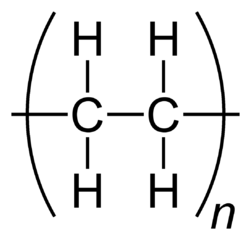I seek to put a layer of fluorine on a rotationally molded cross-linked polyethylene (XPE) plastic gasoline tank. I sell tanks and they will be more eco-friendly if I can accomplish this.
I am an electrical engineer and my last experience with chemistry was Chem 200 lecture and lab at SDSU, a one semester intensive "all of chemistry for engineers" kind of course. I asked a chemistry professor at my alma mater about this, who said:
Xenon difluoride is a powerful fluorinating agent, and is soluble (according to Wikipedia) in anhydrous methyl cyanide and several fluorinated solvents. Offhand, this looks to me like it would do the job, but it's not a friendly compound (toxic, possibly corrosive).
The concept is already in place all around us: any time you buy a plastic jug with harsh chemicals in it, the jug has been fluorinated. So far, the majority of my learning is confirmation that yes, indeed, fluorinating polyethylene (PE) surfaces with $\ce{XeF2}$ leads to decreased gas permeability.
I've done a bit of Googling and bought a couple of great textbooks, Fluoropolymers 1; Synthesis and Fluoropolymers 2; Properties. Fluoropolymers 1 seems to have great stuff in a couple sections. Perusing Fluoropolymers 2, I haven't seen anything jump out at me yet.
There are two methods I have read about:
- Involves an oven, steady high temperature, and plasma discharge.
- "Surface Fluorination of Polymers Using Xenon Difluoride", or Gaseous $\ce{XeF2}$ and PE are placed in a "stainless steel reactor" and left alone.
Seeing the options, the 2nd seems the way to go, and this seems to be the epic equation concerning my quest quoted from Fluoropolymers 1 page 231, section 15.3:
The comparative accessibility and desirable properties of $\ce{XeF2}$ enable its use for the synthesis of fluoroorganic compounds under “mild” conditions. As a fluorinating agent $\ce{XeF2}$ can be used to effect electrophilic fluorination of various organic compounds with good yield and it is a useful reagent for generating radical cations. ... In many cases XeF2 is an attractive alternative to the conventional Balz–Schiemann reaction for the preparation of fluorinated aromatic compounds, e.g., fluorobenzenes:
$\ce{RC6H6 ->C[XeF2] Rc6H5F + Xe + HF ->C[XeF2] RC6H4F2 }$
Xenon difluoride reacts with carbon–carbon single, double, and triple bonds giving addition fluoroorganic compounds, e.g.,
$\ce{R-CH=CH2 ->C[XeF2] RCH2-CHF2 + Xe}$
and
$\ce{RCH2-CH3 ->C[XeF2] RCHF-CH3 + Xe + HF ->C[XeF2] RCF2-CH3 + Xe + HF}$
And this quote from page 236 gives me great hope:
Another argument in favor of the $\ce{XeF2}$ method is the evidence that since 1995 it has been used by a manufacturing company that had no previous experience with direct fluorination or fluorine at all.
... for I'm in the same position now!
How do I actually perform a fluorination surface treatment my XPE products?
Where / how do I go about getting $\ce{XeF2}$? And if it is soluble in a "fluorinated solvent" like my prof said, is there a way I can flush this through the interior of my tanks in a controlled manner that would accomplish some degree of fluorination?
Edited to add 10-22-12: I called a few companies today. Everyone is pointing me to pay Fluoro-Seal to do this. They are the only company providing this service in the US. I'll need to ship my products to them, wait a couple weeks, and pay $15~45 each tank. I'd still like some kind of bath or wash to do this. This is why no-one making replacement tanks has them emissions legal... all this triples my cost.
Edited to add 12-30-13: Fluoro-Seal has given up on fluorinating rotationally molded PE. I'm pushing a plastics manufacturer to develop their existing acetel product to work with rotational molding. Their solution for injection and blow molding is in production and impervious to fuels (they have parts in nearly all automotive fuel systems in the US right now). So there's hope for a solution; however it seems impossible to fluorinate PE.


